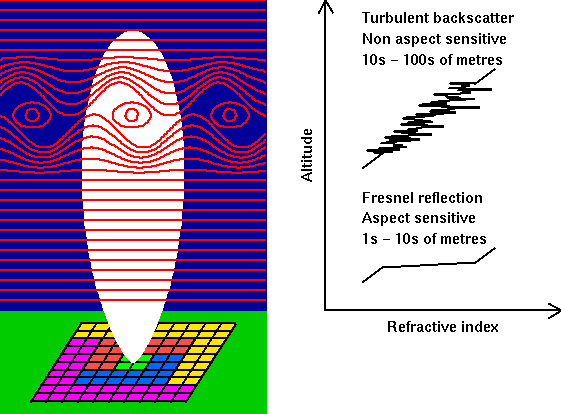
Aspect sensitivity
Lower-VHF radar returns from the lower stratosphere are typically (but
not always) aspect sensitive, i,e, the signal power for a vertically
directed beam is significantly greater than that for an off-vertical
beam at the same altitude (typically > 10 dB for a beam directed
6° off-vertical). However, radar returns from the troposphere tend
to be characterised by low aspect sensitivity. The differences are
explained by the existence of two different mechanisms by which radar
signals are returned from the atmosphere:
Turbulent backscatter
Although the turbulence generation shown (figuratively) above is by a
shear (or dynamic) instability, i.e. a Kelvin-Helmholtz billow
pattern, it could equally well be generated by a convective (or
static) instability. Turbulent mixing across a region characterised by
a vertical gradient of (generalised potential) refractive index
gives rise to refractive index irregularities across a wide range of
scale sizes with a one dimensional k-5/3 dependence within
the inertial subrange. Radar signals are backscattered from all scale
sizes of irregularities but only those irregularities close to half
the radar wavelength (3.2 m in the case of the 46.5 MHz NERC MST
Radar) give rise to constructively interefering returns, hence the
term Bragg scatter also given to this mechanism for radar
returns. Since the half radar wavelength is within the inertial
subrange of turbulence at tropospheric and lower stratospheric
altitudes, the refractive index irregularities are expected to be
isotropic. The (one dimensional) statistical nature of the refractive
index irregularities will therefore be invariant of the angle at which
the turbulent layer is observed and so the radar returns are non
aspect sensitive. The width of turbulent layers generated by shear
instabilities ranges from a few 10's of metres to several hundreds of
metres.
Fresnel (or partial) reflection
Aspect sensitive radar returns are thought to result from partial
reflections from sharp vertical changes in refractive index which are
horizontally coherent over a spatial scale of at least the first
Fresnel zone of the radar. The strongest radar returns occur for radar
beams directed orthogonally to the reflecting layers and decrease as
the angle between the radar beam and the perpendicular to the layer
increases. Clearly the presence of such features is inconsistent with
turbulent mixing which would erode the horizontal coherency. Studies
using high-resolution balloon-borne probes have detected the presence
of `temperature sheets' which are consistent with the refractive index
structures required for partial reflection to take place; sharp
increases of temperature (and hence refractive index) over vertical
distances of the order of a few metres to a few 10's of
metres.
Although the scattering/reflecting layers are nominally horizontal (i.e. parallel to the isentropes) it appears that they can be tilted by up to a few degrees by the effects of gravity waves.

 THE NERC MST RADAR FACILITY AT ABERYSTWYTH
THE NERC MST RADAR FACILITY AT ABERYSTWYTH